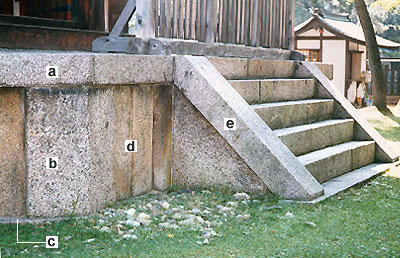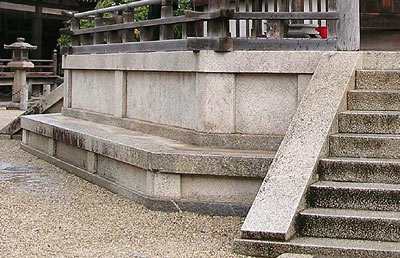A class
of platform or podium specially associated with Buddhist temple buildings
dating from the 7c-12c. It was first introduced from the *Kudara 百済 (Korean:
Paekche) kingdom when Buddhism and its architects came to
Japan (mid-6c) along with many other craftsmen. Stone podii were made primarily
for temple buildings until the late 12c. A new type of podium, made of a
plaster covered mound *kamebara
亀腹 under a building that was surrounded by a veranda, gradually replaced
the stone podii for temple buildings from the early Heian period. The earliest
extant example is Ichijouji *Snajuu-no-tou 一乗寺三重塔 (1171) in Hyougo prefecture. Stone podii are
also called *danjouzumi
壇上積 and can be divided into two basic types: danjouzumi ichijuu kidan
壇上積一重基壇 and danjouzumi nijuu kidan 壇上積二重基壇. The former has one level
while the latter has two. The upper platform is called *jousei kidan
上成基壇, and the lower one is called kasei kidan 下成基壇. Both have one
flight of steps dan-ishi 段石 at the center of each side. The sloping
borders along the steps are called *mimi-ishi
耳石. The construction site for such podii was prepared with mounds of rubble
and several layers of clay piled up to the desired height. Rough stone,
or more rarely granite, was used to contain the mound. The site also included
ground sills *jifuku-ishi
地覆石 that surrounded the mound. Stone posts *tsuka-ishi
束石 were erected and stone panels *hame-ishi
羽目石 were set between. The top surface was finished with square stones or
tiles, or rectangular tiles *shihanjiki 四半敷 that became the floor
of the temple building. Finally, border or curb stones *katsura-ishi
葛石 covered the edges where the vertical frame and the flooring met. Proto-modern
flooring stones were usually set parallel to the length of the building,
but by the end of the 12c, they were more frequently diamond shaped *nunojiki
布敷 or hexagonal. The podium resembles a Buddhist altar *shumidan
須弥壇.
|




